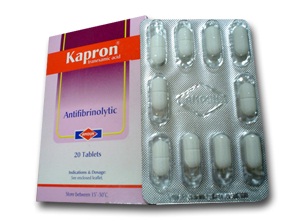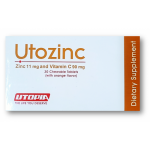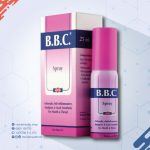
Kapron tablets
Compostion :
Each coated tablet contains:
500 mg tranexamic acid
list of execipients : Croscarmellose Sodium , Sodium stearyl Fumerate , Prosolve 90, Crospovidone Xl, Povidone K30
Pharmacodynamic properties :
Tranexamic acid is an antifibrinolytic compound which is a potent competitive inhibitor of the activation of plasminogen to plasmin. At much higher concentrations it is a non-competitive inhibitor of plasmin. The inhibitory effect of Iranexamic acid in plasminogen activation by urokinase has been reported to be 6-100 times and by streptokinase 6-40 times greater than that of aminocaproic acid. The antifibrinolytic activity of tranexamic acid is approximately ten times greater than that of erninocaproic acid.
pharmacokinetic properties :
Absorption :
Absorption of tranexamic acid after oral administration in humans represents approximately 30-50 % of the ingested dose and bioavailabihty is not affected by food intake
Distribution :
The plasma peak level after 1 g orally is 8 mg per l and after 2 g, 15 mg per L. both obtained three hours after dosing.
The plasma protein binding of Iranexamic add is about 3 % at therapeutic plasma levels and seems to be futty accounted for by its binding to plasminogen.
Tranexamic acid does not bind 10 serum albumin.
An antifibrinolytic concentration of tranexamtc acid remains in different tissues for about 17 hours, and in the serum, up to seven or eight hours .
Tranexamic acid crosses the placenta, and may reach one hundredth of the serum peak concentration in the milk of lactating women.
Elimination After oral administration of 10-15 mg per kg body weight, the cumulative urinary excretion at 24 hours is 39 % and at 48 hours, 41 % of the ingested dose or 78 % and 82 % of the absorbed material. only a small fraction of the drug is metabolized. After oral administration, 1 % of the dicarboxytic acid and 05 % of
the acetytated compound are excreted Plasma concentrations are increased in patients with renal insufficiency.
Therapeutic Indications :
Short-term use for haemorrhage or risk of haemorrhage in increased fibrinolysis or fibrinogenolysis. local fibrinolysis as occurs in the following conditions:
– Prostatectomy and bladder surgery – menorrhagia
– Epistaxis
– Conisation of the cervix
– Traumatic hyphaema ,
– Hereditary angioneurotic oedema
– Management of dental extraction in haemophiliacs
posology and method of administration :
1. local fibrinolysis: The recommended standard dosage is 15-25 mglkg bodyweight (I.e. 2-3 tablets) two to three times daily. For the indications listed below the following doses may be used :
1a- prostatectomy : prophylaxis and treatment of haemorrhage in high risk patients should commence pre- or post-operatively with Kapron III Injection;thereafter 2 tablets three to four times daily until macroscopic haematuria is no longer present,
1b- Menorrhagia: Recommended dosage is 2 tablets 3 times daily as long as needeifor up to 4 days. If very heavy menstrual bleeding. dosage may be increased.A total dose of 4g daily (8 tablets) should not be exceeded. Treatment with Kapron should not be initiated until menstrual bleeding has started.
1c- Epistaxis: where recurrent bleeding is anticipated oral therapy (2 tablets three times daily) should be administered for 7 days.
1d- Conisation of the cervix: 3 tablets three times daily.
le. Traumatic hyphaema: 2-3 tablets three times daily. The dose is based on 25 mglkg three times a day.
2- Hereditary angioneurotic oedema: Some patients are aware of the onset of the illness; suitable treatment for these patients is intermittently 2-3 tablets two to three times daily for some days. Other patients are treated continuously at this dosage.
3- Haemophilia: In the management of dental extractions 2-3 tablets every eight hours. The dose is based on 25 mg/kg.
Renal insufficiency: By extrapolation from clearance data relating to the intravenous dosage form, the following reduction in the oral dosage is recommended for patients with mild to moderate renal insuffidency.
Serum Dose lranexarnic acid
Creatinine
(umol/l)
120-249 15 mg/kg body weight twice daily
250-500 15 mg/kg body weight/day
Children’s dosage: This should be calculated according to body weight at 25 mglkg per dose. However, data on efficacy, posology and safety for these indications are limited.
Elderly patients: No reduction in dosage is necessary unless there is evidence of renal failure .
Contraindications :
– Hypersensitivity to tranexamc acid or any of the other ingredients
– Severe renal impairment because of risk of accumulation
– Active thromboembolic disease.
– History of venous or arterial thrombosis
– Fibrinolytic conditions following consumption coagulopathy
– History of convulsions
Special warnings and precautions for use :
In case of haematuria of renal origin (especially in haemophilia), there is a risk of mechanical anuria due to fonnation of a ureteral dol
In the long-term treatment of patients with hereditary angioneurotic oedema, regular eye examinations (e.g. visual acuity, slit lamp, intraocular pressure, visual fields) and liver function tests should be performed. $ Patients with irregular menstru~bleeding should not use Kapron until the cause of irregular bleeding has been established. If menstrual bleeding is nol adequately reduced by Kapron ,an alternative treatment should be considered Tranexamic acid should be administered with care in patients receiving oral
contraceptives because of the increased risk of IJvombosis. Patients with a previous thr.omboembolic event and a family history of thromboembol~ disease (patients with thrombophilia) should use Kapron only if there is a strong medical indication and under strict medical supervision. The blood levels are Increased in patients with renal insufficiency. Therefore a dose reduction is recommended. The use of tranexamic acid in cases of increased fibrinolysis due to disseminated intravascular coagulation is not recommended.
Patients who experience visual diiturbance should be withdrawn from treatmenl Clinical experience with Kapron in menorrhagic children under 15 years of age is not available.
Pregnancy and lactation :
Pregnancy
Although there is no evidence from animal studies of a teratogenic effect the usual caution with use of drugs in pregnancy should be observed. Tranexamic acid crosses the placenta.
lactation
Tranexamic acid passes into breast milk to a concentration of approximately one hundredth of the concentration in the maternal blood. An antifibrinolytic effect in the infant is unlikely.
Effects on ability to drive and use machines :
None known.
Undesirable effects :
Adverse events are listed below by system organ dass and frequency. Frequencies are defined as: very common (:? 11!01, common (:? 1{100 and <1/10), uncommon
( >1/1000 and <1/100), rare (> 1/10,000 and <t/l000) and very rare «1{10,000) including isolated reports, not known (cannot be estimated from the available data).
Immune system disorders
Very rare: Hypersensitivity reactions including anaphy1axis
Eye disorders
Rare: Colour vision disturbances, retinal/artery occlusion
Vascular disorders ‘
Rare: Thromboembolic events
Very rare: Arterial or venous thrombosis at any sites
Gastro-intestinal disorders
Very rare: Digestive effects such as nausea, vomiting and diarrhoea, may occur but disappear when the dosage is reduced.
Skin and subcutaneous tissue disorders
Rare: Allergic skin reactions
Overdose :
Symptoms may be nausea, vomiting. orthostatic symptoms and /or hypotension initiate vomiting. then stomach lavage, and Charcoal therapy. Maintain a high fluid intake to promote renal excretion. There is a risk of thrombosis in predisposed individuals. Anticoagulant treatment should be considered.
Predinical safety data :
There are no preclinical data of relevance to the prescriber which are additional to that already included in other sections of the Summary of Product Characteristics.
How supplied :
Strips of 10 tablets in packs of 2 strips.
Keep all medicaments out of reach of children
Produt of :
Amoun pharmaceutical co SAE cairo egypt.

